Uptake of coronavirus vaccines in older teenagers appears to have stalled already, according to UK Government figures.
Only around 55 per cent of 16 and 17-year-olds in England had their first dose by September 26, latest data shows, a number which had barely risen in the previous three weeks.
Meanwhile, fewer than 10 per cent of 12 to 15-year-olds have come forward for their vaccine. But it only includes one week of data from the point when the majority of teens were eligible.
The analysis was revealed in a weekly report by the new UK Health Security Agency, which took over axed Public Health England’s pandemic duties today.
It showed that uptake in the age group was sitting at about 20 per cent at the start of August. This shot up to 50 per cent in the three weeks after the roll-out was expanded to all older teenagers on August 19. But the progress appears to have stalled in recent weeks, rising just five or so per cent in September.
All age groups have seen a natural stagnation in uptake, with the threshold being much higher in older age groups who are most susceptible to getting severe Covid. For example, the ceiling was about 90 per cent in the over-70s and 80 per cent in people over the age of 50.
Experts said they were not necessarily surprised by the plateau. Cambridge University epidemiologist Dr Raghib Ali told MailOnline the enthusiasm for jabs in older teenagers was lower because so many have already had Covid ‘so don’t feel they need to get vaccinated’.
Chris Whitty, England’s chief medical officer, revealed earlier this month that about half of children had caught the virus at some point already and therefore developed some immunity. Official figures today also suggested one in 20 children were carrying the virus on any given day last week.
‘There is no doubt that all vaccines in current use are very good at protecting a vaccinated person from getting infected and getting severe disease but a prior infection does that just as well,’ according to Professor Paul Hunter, a medical expert at the University of East Anglia.
He told MailOnline: ‘So ultimately I am not particularly concerned about the current low uptake of the vaccine in this age group.’
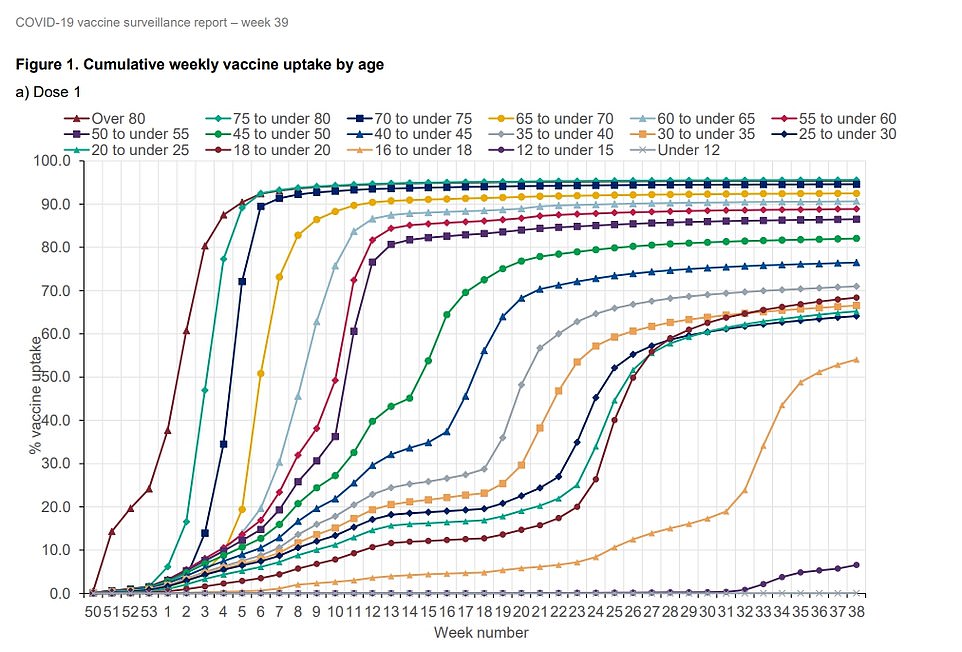
Only around 55 per cent of 16 and 17-year-olds have had their first dose by September 26 (titled week 38), a number which had barely risen in the previous three weeks. Data from the new UK Health Security Agency shows that uptake in the age group was sitting at about 20 per cent at the start of August
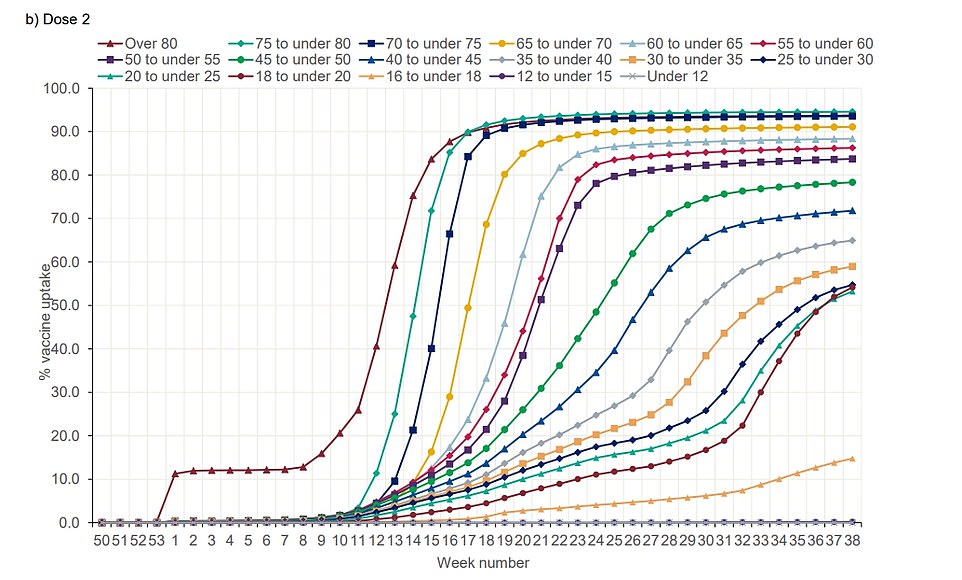
Second doses are running at about half the rate of first doses in older teens. but this is because of the eight-week delay between doses
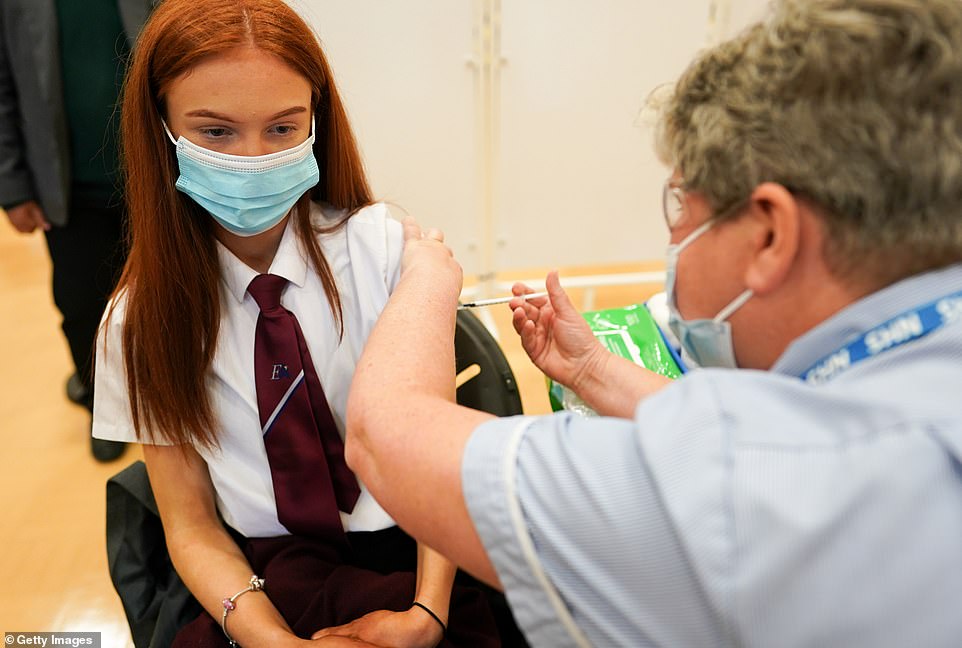
Fifteen-year-old Lauren McLean became one of the first under-16s to receive a Covid vaccine at the Excelsior Academy in Newcastle-upon-Tyne last week
Dr Simon Clarke, an infectious diseases expert at the University of Reading, echoed Professor Hunter’s comments, saying he too was ‘not surprised’.
‘We already knew that younger adults were more difficult to reach than their parents and grandparents,’ he told MailOnline. ‘You’ll always find that there’s a part of any age group that are the keenest to get vaccinated, and they’ll take it first.
Hundreds of schools told to be ‘proactive’ and roll back suite of Covid curbs including masks and bubbles
Schools have been instructed by councils to bring in a suite of stricter Covid curbs in response to rising infections among pupils.
Hundreds of primaries and secondaries in Staffordshire were urged to be ‘proactive’ and not wait on official guidance from the Government.
The county’s council has encouraged bringing back face masks and year group bubbles and scrapping assemblies and staff meetings. It also recommended schools stagger starting and break times to limit mixing in corridors and the playground.
Staffordshire County Council, which covers more than 400 schools, is believed to be the first to promote reintroducing such a comprehensive set of measures.
Other local authorities have brought back light measures like mask-wearing, including Cumbria and parts of Northamptonshire.
Pupils whose family member tests positive are advised to ‘stay at home pending PCR test result’, despite the fact schools can’t legally make them isolate.
Ministers scrapped the requirement for all contacts of Covid cases to self-isolate in August.
The Government, keen not to take a backward step after releasing restrictions in July, says schools can only roll back curbs if school infection levels get too high.
It’s unclear how many pupils or staff have tested positive in Staffordshire but the council claims it has the backing of cabinet ministers.
The Department for Education says schools can take action into their own hands if five pupils or staff linked to each other test positive for Covid within a 10-day period.
They have also been given the power to do it if 10 per cent of pupils or staff in a school test positive within 10 days.
A document circulated by the council in Staffordshire says it has the backing of the local director for public health and Government ministers.
The Tory county’s infections surged rose by more than a quarter last week, but more than 30 places had higher infection rates in the UK.
Jonathan Price, Staffordshire County Council’s cabinet member, said cases were concentrated in secondary and college outbreaks.
Advertisement
‘Next will be the people who are less worried about their health, they will take more persuading and some of them just won’t have got around to it.
‘And then there are the people who don’t want it, either because they genuinely don’t see the need or they are hostile to the idea of vaccinating this age group because they think it’s unsafe.
‘It seems that the younger the age group, the less enthusiastic they are for the vaccine, either because they think it’s unnecessary or they aren’t convinced it’s safe for their age group.’
The rollout was officially opened to healthy 12-15 year olds last week after months of deliberation about the risks and benefits.
Vulnerable children in this age group were first invited for their vaccine in July when health chiefs concluded that the benefits of vaccine clearly outweighed the small risk of heart inflammation associated with the jabs in kids.
But the Joint Committee on Vaccination and Immunisation (JCVI) advised against routinely vaccinating healthy 12 to 15-year-olds, who it estimates have just a one in 2million chance of dying from Covid.
The JCVI urged ministers to seek advice from Professor Whitty and his fellow chief medical officers in the devolved nations about the wider benefits vaccination could provide.
They ultimately ruled in favour of the move to prevent school closures.
Children under 16 are only being given a single dose of Pfizer’s vaccine but older teens will get both.
Health chiefs are still weighing up whether it’s worth giving younger ages both doses because the second injection slightly increases the risk of health inflammation, called myocarditis.
But the side effect is still very rare, affecting one in 10,000. In most cases it’s mild, but scientists don’t know the long-term implications.
In total, there are thought to be around 3.5million 12 to 15-year-olds in the UK, including both vulnerable and fit and healthy children.
The UKHSA data only goes up to September 26 and the rollout only began in healthy under-16s on September 20.
It comes official statistics showed one in 20 children in England were infected with Covid on any given day last week.
The Office for National Statistics today estimated 658,800 people in England had the virus on September 25, up 6.2 per cent on the previous weekly figure.
Analysis showed the virus was most prevalent among children aged 11 to 16, with 4.6 per cent of them estimated to have been infected – the equivalent of around one infected pupil in every classroom.
With the outbreak having exploded among pupils since they went back at the start of September, some scientists have urged secondary schools to reintroduce face masks immediately to prevent infections tricking into the rest of the population.
Meanwhile, bosses at Staffordshire County Council today urged 500 schools to be ‘proactive’ and reimplement infection control measures that were scrapped by No10 in mid-May, including bubbles and contact-tracing.
The ONS data, which is closely watched by ministers, barely changed in any other age groups last week, despite a flurry of other official statistics suggesting the outbreak has already started to spill over.
One scientist behind one of the country’s largest Covid surveillance studies yesterday warned infections were now spreading up the ‘generational ladder’.
The estimated infection rates among 11 to 16-year-olds in England marks a rise from the 2.8 per cent who were thought to be infected one week earlier.
Children aged two to 10 have the next-highest infection rate, with around one in 40 (2.6 per cent) of them thought to have the virus on any given day last week, up from 2.3 per cent one week earlier.

The graphs show the Office for National Statistics estimates for the percentage of people testing positive in England for different age groups from August 15 to September 25. The virus was most prevalent among children aged 11 to 16, with 4.6 per cent of them estimated to have been infected – the equivalent of around one infected pupil in every classroom
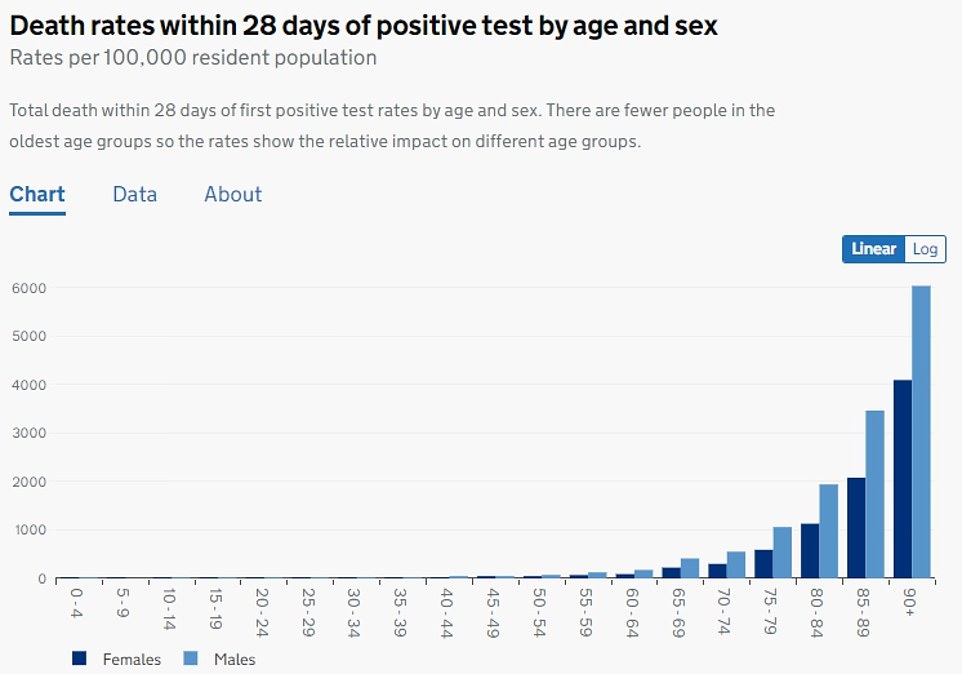
Latest official figures show that within 28 days of testing positive for the virus, 0.5 girls aged 10 to 14 will die from the virus per 100,000. The figure for boys of the same age is 0.3 per 100,000
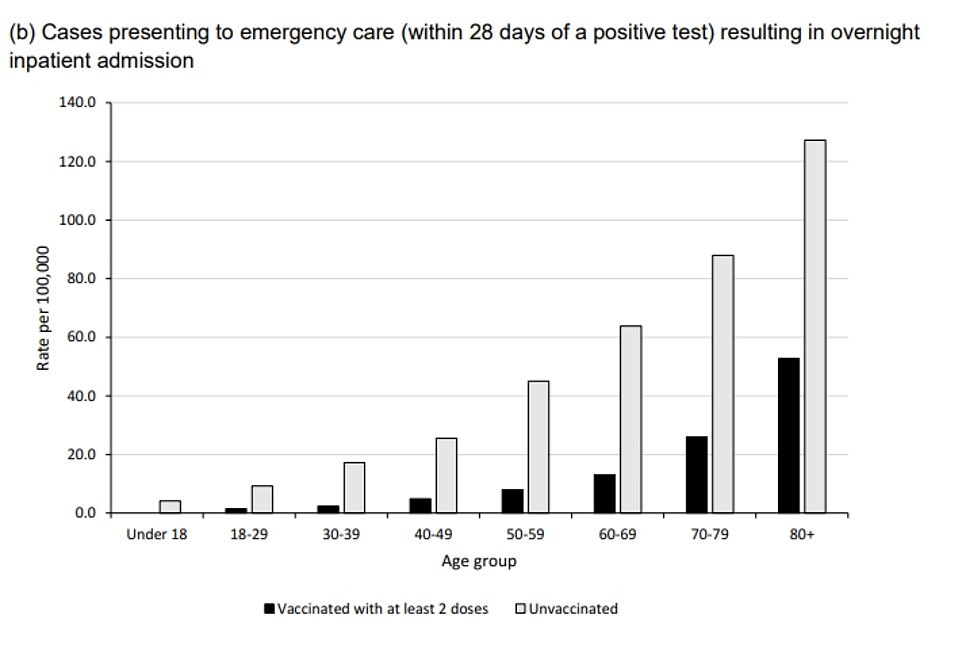
Public Health England’s report showed unvaccinated people were up to five times more likely to be hospitalised with Covid in August compared to those who had got both doses. The above graph shows the Covid hospitalisation rate among the unvaccinated (grey) compared to the vaccinated (black). The rate for Covid hospitalisation was worked out by dividing the total number of vaccinated and unvaccinated people who were admitted to hospital with the virus by the total number of people in each category in the population in England
Covid is now in every classroom, figures suggest
One in 20 children in England were infected with Covid on any given day last week, official data revealed today amid fears a fourth wave may be just around the corner.
The Office for National Statistics today estimated 658,800 people in England had the virus on September 25, up 6.2 per cent on the previous weekly figure.
Analysis showed the virus was most prevalent among children aged 11 to 16, with 4.6 per cent of them estimated to have been infected – the equivalent of around one infected pupil in every classroom.
With the outbreak having exploded among pupils since they went back at the start of September, some scientists have urged secondary schools to reintroduce face masks immediately to prevent infections tricking into the rest of the population.
Meanwhile, bosses at Staffordshire County Council today urged 500 schools to be ‘proactive’ and reimplement infection control measures that were scrapped by No10 in mid-May, including bubbles and contact-tracing.
The ONS data, which is closely watched by ministers, barely changed in any other age groups last week, despite a flurry of other official statistics suggesting the outbreak has already started to spill over.
Advertisement
Cases are also rising among the over-70s, with an estimated 0.5 per cent of them infected, compared to 0.4 per cent last week.
But cases are falling or flat in all other age groups. Among 17 to 24-year-olds, 1.1 per cent are thought to have Covid, down from 1.5 per cent last week, while 0.6 per cent of 25 to 34-year-olds had the virus last week, a drop from 0.7 per cent.
Meanwhile, 0.8 per cent of people aged 35 to 49 had the coronavirus and 0.7 per cent of those aged 50 to 69 – the same as the previous week.
The uptake in cases among younger groups led Staffordshire County Council to tell schools to bring back wide-ranging measures to control the outbreak in the area, which has seen infections surged by 28.8 per cent in a week.
The council said pupils should wear face coverings, while staff should stay 2m away from students. And there should not be any all-staff meetings or all-school events, such as assemblies, it advised.
It also told pupils living with someone who tests positive to stay at home until they receive a negative PCR test, despite not being able to legally enforce this measure.
Professor Christina Pagel, a mathematician at University College London, this week called for infection control measures to be brought back at a national level.
She said: ‘I think we need to put mitigations back in schools, particularly masks in secondary schools, now and roll out the vaccine a bit more rapidly.’
Professor Pagel warned the spiralling infection rates in children, risks of them suffering ‘long Covid’ and a slow vaccine roll out meant action should be taken to limit the spread of the virus.
It comes as the ONS data shows infections across the UK are a mixed picture. Cases are rising in England and Wales, where one in 85 (1.21 per cent) and one in 55 (1.76 per cent) people were estimated to have Covid last week, respectively.
Meanwhile, cases are dropping in Scotland, where one in 65 people (1.85 per cent) were infected last week, down from one in 45 (2.28 per cent) in the seven days up to September 18.
And one in 65 people in Northern Ireland (1.53 per cent) had the virus last week, a drop from one in 60 one week earlier, according to the official estimates.
Source link : https://www.dailymail.co.uk/news/article-10049933/Vaccine-uptake-stalled-55-16-18-year-olds-official-data-shows.html











